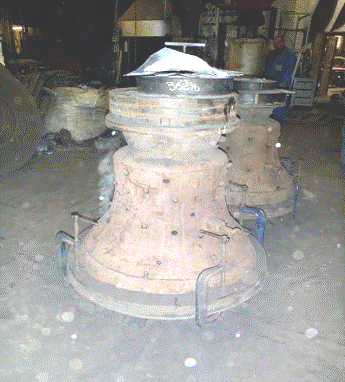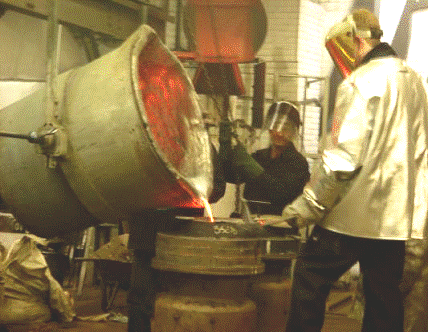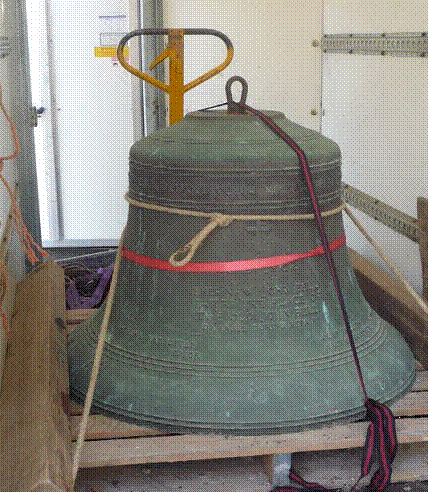Pitcombe, Somerset, Restoration Project
From Brian Shingler, October 2013
Following the launch of fund-raising for this project, progress has gathered pace. The new tenor, a bell found through the Keltek Trust, has been purchased and transported to the Whitechapel Foundry, and on 10th October 2013, three Pitcombe ringers were fortunate enough to be at the foundry to watch our two new treble bells being cast.

The moulds had been made during the three weeks prior to our visit. Despite technological advances the basic principles of bell founding remain the same. A metal moulding gauge or strickle is made for each bell. The mould is made of loam, a mixture of sand, clay, horse manure, goats hair and water which is applied by hand inside an iron flask, then smoothed to an exact profile of the outside of the bell using a strickle, this half of the mould is the cope. The inner mould or core is built on a flat iron bed plate and constructed of loam formed over a hollow brick foundation and is shaped using the inner edge of the strickle or moulding gauge. When almost finished a craftsman impresses in the cope (in reverse) any inscription required so when cast this stands out in relief on the surface of the bell. It takes three weeks to produce a batch of moulds. Each half takes a few days to make and a few more drying in an oven. Then the two halves are coated with graphite to give a smooth finish and prevent the molten metal from penetrating the mould. These are then firmly clamped together leaving a space between them which corresponds to the precise shape, size and thickness of the bell to be cast. 
Bell metal consists of approximately 77% copper and 23% tin. The metal is heated in a furnace near the casting area where we stood to observe the process. We were told the furnace had been heating the metal since the foundry opened the day of our visit, and at 2.30pm it had reached the required temperature. This is what we saw – the furnace was tapped and the metal run off into a huge ladle, skimmed to remove impurities and then poured into the two moulds.
When the metal has cooled, the cope is lifted off to separate the mould. The bell is removed, breaking away the loam; it is cleaned ready for testing, drilling and tuning. A bell produces not just one note but some forty discernible harmonic tones, which blend to give the bell its tone. Modern bell founders have realised that by bringing the five most prominent partial tones accurately into tune, the tone of a bell can be greatly improved. A bell is cast as near to the desired note as possible, but some adjustment is usually necessary both to correct its partial tones and also to bring it accurately in tune with the rest of the bells in the ring. This is achieved by cutting metal from the inner surface of the bell on a lathe, and by carefully measuring the frequencies using modern electronic equipment. Our two medieval bells cannot be tuned but by adding a larger and two smaller bells our three A minor bells will be transformed into a ring of six in G major.
 The existing bells will be lowered and taken to Whitechapel, the medieval ones for new ropes and wheels and the present tenor for refurbishment and for tuning.
The existing bells will be lowered and taken to Whitechapel, the medieval ones for new ropes and wheels and the present tenor for refurbishment and for tuning.
Building work is required to get ready for a new frame to be installed below the present one for the additional bells and we hope the project will be completed by the end of April 2014.
Thank you to all those who have encouraged us to take on this project and generously given donations. Applications for grants have been sent and two major fund-raising events planned. The first of these was an Auction of Promises at Hadspen Village Hall.
We look forward to welcoming you to St Leonard’s to ring our new harmonious peal of six bells.
Pitcombe PCC and Friends of St Leonard’s Church
